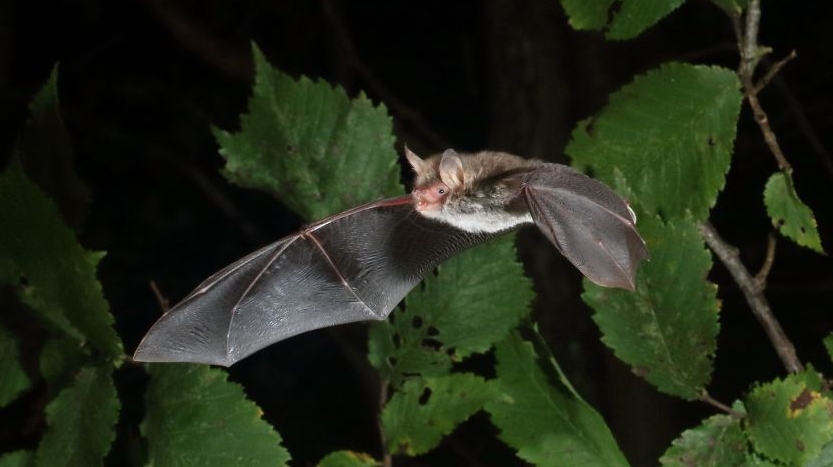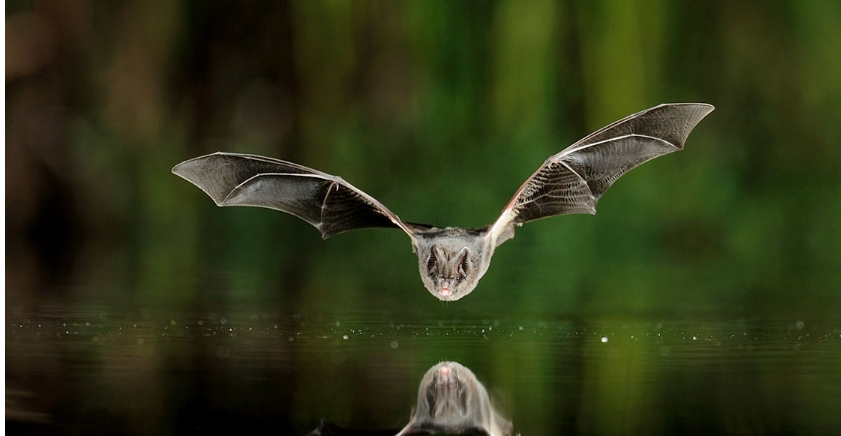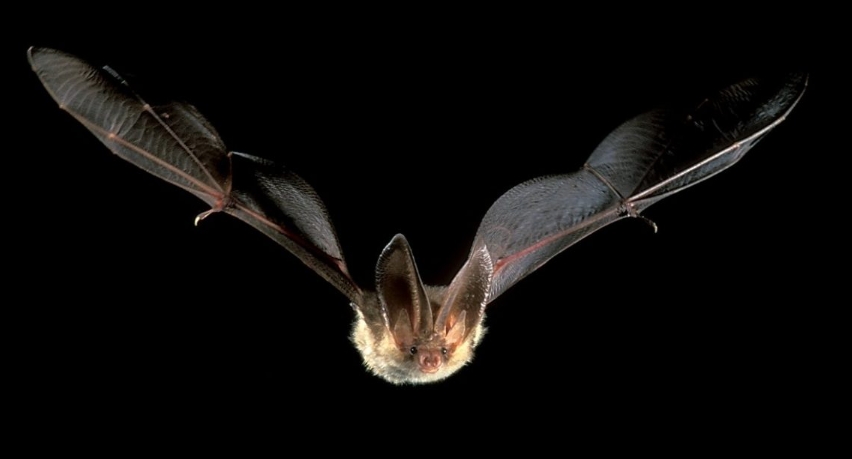
A recent Italian study analyzes the diet of two rare species of forest bats, the barbastello and the brown long-eared bat, showing how it is based on a large quantity of insects harmful to the vegetation. Predation by these two bats is an advantage both for the forest in which they live and for the surrounding cultivated areas. Therefore, protecting the barbastelle and the brown ear means safeguarding not only the forests, with the ecosystem services they offer us, but also agriculture.
On Science on the Net we have repeatedly written about how bats, although often perceived negatively (for example, in relation to zoonoses), actually have enormous value for ecosystems, for example for the control they can exercise on harmful insects. Most of the studies on the role of insectivorous bats have so far taken place in the United States and have focused above all on some rather widespread species and on the environments of greatest economic value for our activities, such as agricultural areas. Now, a work conducted by researchers from the Federico II University of Naples, the University of Milan Bicocca and the Institute for the Sustainable Protection of Plants of the CNR is starting to collect some important information also for Italy, information all the more precious because concern two species of bats already rare and threatened.
The study, which sees Leonardo Ancillotto as first author and is led by Danilo Russo, both of the Federico II University of Naples, analyzes the diet of the barbastelle (Barbastella barbastellus) and the brown long-eared (Plecotus auritus) showing how the two species, although linked to the forest environment – and in particular that of forests not managed by humans – they can help protect both the forest and the surrounding agricultural areas, because they feed on numerous species of insects harmful to plants.
The refuge in the ancient forests
“This study is grafted onto two lines of research that we have in progress, one concerning the ecology of forest bats, which are relatively little known, and the other on the diet of bats, for which the molecular techniques developed the last twenty years have made it possible to achieve much greater detail than was previously possible”, explains Russo. “Both the barbastello and the brown long-eared are insectivores closely linked to mature forests: for this reason, our study was carried out in the National Park of Abruzzo, Lazio and Molise, which includes beech woods that have remained undisturbed for at least fifty years”.

In this ecosystem there are therefore many generations of forest, dead trees and other elements that support a remarkable biodiversity (not surprisingly, other rare species are also found here such as the Lilford woodpecker and the Rosalia of the Alps). It is an environment that is not unique, but certainly not very widespread in Europe where, although forest cover has increased over the last few years, undisturbed forests, i.e. not subject to human management for at least fifty years, only exist around 2.2%. In the beech woods of the Park, the presence of mature trees, with much thicker trunks than those which could be found, for example, in coppice woods, allows bats to find suitable shelters: in particular, the barbastello is linked to the desquamation cavities of the trunks dead, while the brown ear uses deeper cavities, such as those dug by woodpeckers.
A diet rich in harmful species
For one month (between June and July 2019), the authors of the study captured the bats and kept them briefly in cotton bags, from which they then removed the droppings before releasing the animals. The droppings were then analyzed to identify the DNA of the ingested insects, from which it was then possible to trace the species, or at least the genus.
“We expected that the bats’ diet would include many essentially forest insects, and could therefore play a role in protecting the forest from harmful species,” explains Russo. “But two important elements emerged from the analysis. The first is that these bats feed on insects that are not only harmful to the forest ecosystem but also to the surrounding agricultural areas, including many Lepidoptera (the order that includes moths and butterflies), Diptera which are known for their impact on crops and also emerging harmful species, in particular the Nysius cymoides or ligeide of rapeseed, a phytophagous hemiptera that has caused significant damage to crops in recent years. And, even if the molecular techniques employed do not allow us to obtain quantitative estimates, we have seen that the frequency of these insects in the diet of bats is significant and can have an important impact on plant protection: for example, the diet of the brown long-eared may include up to 85% insect pests.”
The first key message that emerges from the analysis, therefore, is that protecting the habitat of the long-eared ear and the barbastelle means not only protecting the forest from these insects, but also the surrounding agricultural areas that can be damaged by them. In fact, not only do some of these insects populate both ecosystems, but at least the barbastello also hunts over large areas, coming out of the woods and feeding on the surrounding fields.
Complementary diets
“A second interesting element that emerged from the survey is that the diet of the barbastelle and the brown long-eared ear are complementary, i.e. there is only a partial overlap of the species they feed on,” explains Russo.
In fact, of the 71 groups of insects on which the barbastelle feeds and of the 69 identified for the brown long-eared ear, only 52 are “in common”, preyed upon by both species.

This depends, in part, on the different hunting techniques implemented by the two species. Some moths, for example, have evolved tympanic organs which allow them to perceive the arrival of the predator and implement evasive maneuvers (for example by dropping or looping in flight) and which make them relatively resistant to predation by numerous species of insectivorous bats. But, in the case of the barbastelle and the brown long-eared ear, these strategies are not enough: in the arms race that characterizes the relationship between prey and predator, even bats have evolved systems that allow them to reach the moth. The barbastelle, for example, emits very weak ultrasounds (we speak of stealth echolocation, i.e. a discrete, invisible echolocation) which the moth can only perceive when the predator is by now close and escape is impossible; the brown eared ear, on the other hand, is able to passively hear the noise that the moth makes when it lands on the vegetation.
“Combined with the fact that the two species exploit partially different hunting territories, with the long-eared ear more linked to the forest environment and the barbastel capable of spreading to the surrounding areas as well, these different hunting strategies are probably at the basis of the complementarity observed in the diet”, continues the researcher. “However, the fact that B. barbastellus and P. auritus feed on different insects indicates that by keeping bat communities healthy, it is possible to maximize the benefits they offer by targeting many different groups of insect pests.”
Two for the price of one: the protection of forests and agricultural areas
“Usually, it is the most abundant species in a given range that provide the majority of ecosystem services. For this reason, studies focusing on the ecological role of rare species are scarce; however, from what emerges from our work, both the barbastelle and the brown long-eared are real specialists, “shock troops” for the protection of the forest”, comments Russo.
The study of the diet cannot demonstrate in an incontrovertible way that the predation by these two species allows to keep the populations of insects under control, from the demographic point of view; for this reason, we prefer to speak of a role of “suppression” rather than actual control. However, the fact that the diet of the two bats is so rich in harmful species suggests that they still play a very important role in the protection of forest ecosystems and agroecosystems.
Both the barbastello and the brown long-eared are endangered species in Italy: the first is currently classified as endangered by the IUCN, while the second is classified as close to being threatened: one of the main reasons is the loss of habitat, precisely due to the scarcity of undisturbed forests in our area. If we consider together the enormous value of forests, in terms of the ecosystem services they provide us, and the role of forest bats in the protection of both the forest and the surrounding agricultural areas, it becomes particularly evident how important it is to protect these ecosystems, often placed at risk not only from poorly sustainable management but also from the effects of climate change, such as fires, which also in many cases favor the spread of harmful insects.
“It is known that bats that inhabit agricultural areas are a protection for crops, but much less known is the role that forest species also have. The possible protection action of both ecosystems by the two species we have studied, on the other hand, underlines once again how much the protection of biodiversity can lead to benefits that go beyond the single protected system. Furthermore, it is worth noting that many insects do not exhibit ‘noxious’ behavior just because they are kept at bay by their natural enemies, including bats, but can become so if predators decrease or disappear,” concludes the researcher.

